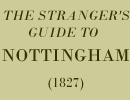< Previous | Contents | Next >
The next object worthy of our notice is
CHAPEL BAR.
This being the west entrance into the town, was in ancient times, guarded by a gate or bar, on one side of which a chapel was erected; hence came the name of Chapel-bar. At present, the width of the street, which is only twenty-six feet, is a great source of inconvenience, and it is much to be wished, that the Corporation, from their ample funds, would enlarge it, and thus add incalculably to the beauty of the market-place, as well as to the convenience of travellers. At the outside of Chapel-bar, to the left, the bottom house in Park-row, stands
ST. NICHOLAS'S WORKHOUSE,
which was built for a private house, but was in 1813, purchased by the parish, and appro. priated to its present purpose. Mr. Thomas Cheetham is the governor, and the average number of paupers within its precincts is 40. Leaving this place, and proceeding up the road, after passing the weighing engine, on the left hand, we come to a neat row of buildings on the right, called
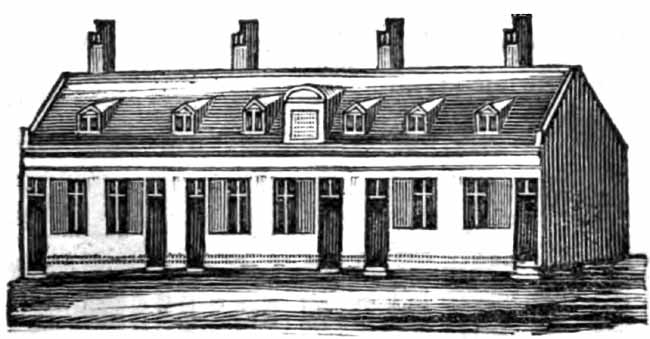
LABRAYS HOSPITALS.
These consist of six tenements, built about the year 1700, for six poor and aged frame. work-knitters. Its benefits are restricted by the express will of the founder to the male sex, and the right of presentation is in Samuel Smith, Esq. the banker. The inmates receive each four shillings a week. A little higher up, on the same side, is the
LANCASTERIAN SCHOOL.
This is a plain building, of one story, erected in the year 1815, by the generosity of the public, principally by the dissenters, for the instruction of boys on the Lancasterian system. The master is Mr. Joseph Lang. with, and it is open for the inspection of the public, every Thursday forenoon. A few yards higher stand
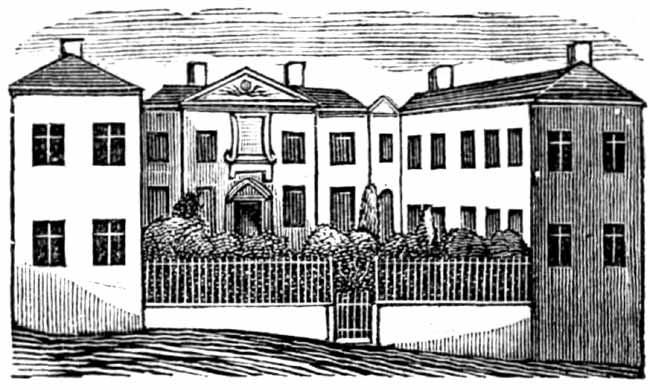
LAMBLEY HOSPITALS,
so called, because the estate which built and endowed them, is situate at Lambley, in this county. The building consists of a centre and two wings, with a small grass plat in front, and preserved from the road by a low wall and iron palisades. Here are twenty-two rooms, in which twenty-two burgesses or their widows, find an asylum in their old age. The right of presentation is in the Corporation of Nottingham. When arrived at the top of the hill, the stranger needs informing, that he here steps out of the town into the county, the numerous houses before him, forming a part of the populous village of New Radford. The right-hand road before us leads to Eastwood and Alfreton, the middle one to Wollaton and Ilkeston, and the one to the left-hand leads to Stapleford and Derby; by taking the latter, we very soon arrive at a gate, which opens into
THE PARK;
which, though in the county, is such an adjunct to the town, that it cannot with propriety be omitted in such a work as this. Here is one of the most beautiful, picturesque, and extensive prospects in the kingdom. At a distance of nearly twenty miles to the east, the princely mansion of the Duke of Rutland, Belvoir castle, may be plainly seen on a fine day, and so may also the Leicestershire hills; to the south, over the majestic river Trent, is the well-known grove of Clifton; while nearer still is to be seen, the castle of Nottingham, and at the western extremity of the park are
THE BARRACKS,
which were built in the year 1792. These present to the eye a handsome brick building, containing well constructed apartments for the officers, a suttling house, stabling for three troops of horse, an hospital, &c, the whole of which, embracing an extensive yard, for exercise, is walled round with brick. Going towards the castle, is a beautiful promenade, much frequented by the inhabitants of the town, many of whom, take a daily walk here for air and exercise. Passing out at a gate at the end of this walk, we come again to the town, and turning to the right,
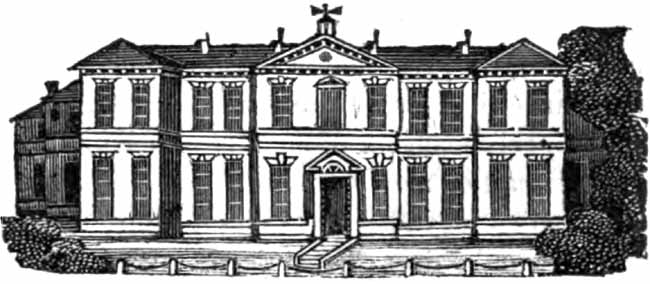
THE GENERAL HOSPITAL
presents itself to our view. This most useful building, for the reception of the sick poor of any county or nation, was built in the year 1781, on about two acres of ground, including the gardens, given by the Corporation and His Grace the Duke of Newcastle. About sixty in-patients are constantly within the walls, and the number of out-patients on the books average between four and five hundred. A charity so extensive as this, requires great support, and it receives subscriptions and donations to a large amount. But no case can be attended to, excepting accidents, without a recommendation from a subscriber. Passing from hence down Jameses-street, are many of the best houses in the town, conspicuous amongst which stands the residence of James Hooley, Esq. on the left-hand side. Lower down, on the opposite side, through an iron gate-way, we have a view of
ST. JAMES'S-STREET CHAPEL,
erected in the year 1825, for the use of a congregation of Independents, under the pastoral care of the Rev. R. Cecil. Retracing our steps, on the south side is Granby-street, at the corner of which is the extensive iron foundry of Messrs. Boothby and Co. Turning to the right is Rutland-street, where, on the south-side, is the
FEMALE SCHOOL OF INDUSTRY.
This is a plain brick building, where about two hundred girls are instructed in reading, writing, and plain needlework; and on the Sabbath it is occupied as a school for girls, belonging to
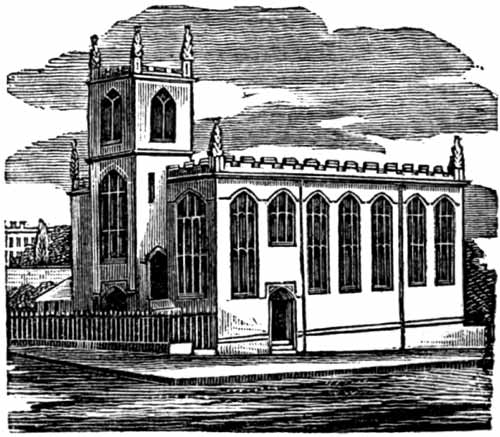
ST. JAMES'S CHURCH.
This building, opposite the top of Rutland-street, is elegantly built with a facing of stone, and has a small tower, with one bell. This place of worship, which was built in the year 1808, is very commodious in the inside. The minister, the Rev. J. B. Stuart, is one of the evangelical clergy, and the congregation is very wealthy and respectable. The services on the Sunday are at halfpast ten, three, and halfpast six, and every Wednesday at halfpast six in the evening. The erection is, however, though the stranger would not suspect it, in the county of Nottingham, being built on what is called Standard-hill, the place where the unfortunate Charles I. planted his standard, in August, 1642. This church or chapel of ease, is surrounded by many well built houses, conspicuous amongst which, is the mansion of Daniel Freeth, Esq. facing the
CASTLE LODGE,
which is a part of the ancient wall and its appendages, which surrounded the old Castle, in ages that are long since gone by. The Gothic arch over the gateway is deserving attention; it rests upon two antiquated bastions, which were formerly used for the defence of the gateway, and one of which, on the left hand side, has been converted into a residence for
